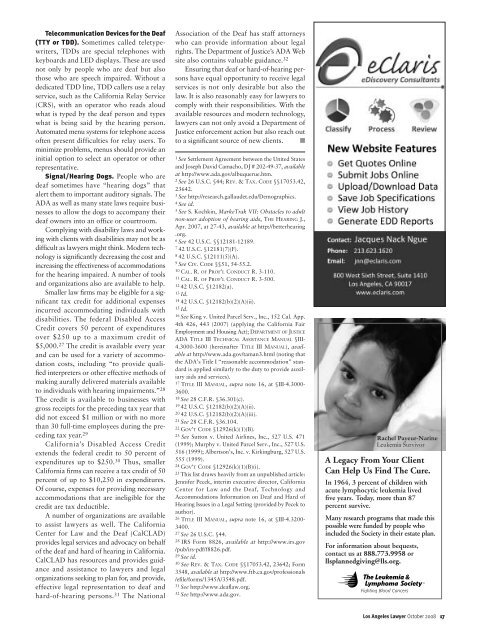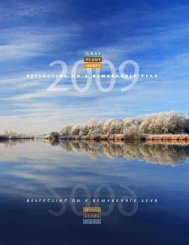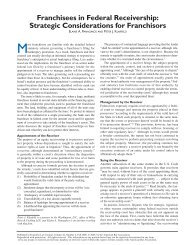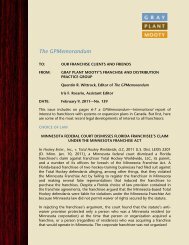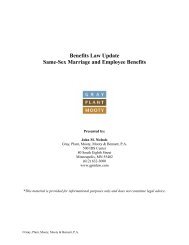Los Angeles Lawyer October 2008 - Gray Plant Mooty
Los Angeles Lawyer October 2008 - Gray Plant Mooty
Los Angeles Lawyer October 2008 - Gray Plant Mooty
You also want an ePaper? Increase the reach of your titles
YUMPU automatically turns print PDFs into web optimized ePapers that Google loves.
Telecommunication Devices for the Deaf<br />
(TTY or TDD). Sometimes called teletypewriters,<br />
TDDs are special telephones with<br />
keyboards and LED displays. These are used<br />
not only by people who are deaf but also<br />
those who are speech impaired. Without a<br />
dedicated TDD line, TDD callers use a relay<br />
service, such as the California Relay Service<br />
(CRS), with an operator who reads aloud<br />
what is typed by the deaf person and types<br />
what is being said by the hearing person.<br />
Automated menu systems for telephone access<br />
often present difficulties for relay users. To<br />
minimize problems, menus should provide an<br />
initial option to select an operator or other<br />
representative.<br />
Signal/Hearing Dogs. People who are<br />
deaf sometimes have “hearing dogs” that<br />
alert them to important auditory signals. The<br />
ADA as well as many state laws require businesses<br />
to allow the dogs to accompany their<br />
deaf owners into an office or courtroom.<br />
Complying with disability laws and working<br />
with clients with disabilities may not be as<br />
difficult as lawyers might think. Modern technology<br />
is significantly decreasing the cost and<br />
increasing the effectiveness of accommodations<br />
for the hearing impaired. A number of tools<br />
and organizations also are available to help.<br />
Smaller law firms may be eligible for a significant<br />
tax credit for additional expenses<br />
incurred accommodating individuals with<br />
disabilities. The federal Disabled Access<br />
Credit covers 50 percent of expenditures<br />
over $250 up to a maximum credit of<br />
$5,000. 27 The credit is available every year<br />
and can be used for a variety of accommodation<br />
costs, including “to provide qualified<br />
interpreters or other effective methods of<br />
making aurally delivered materials available<br />
to individuals with hearing impairments.” 28<br />
The credit is available to businesses with<br />
gross receipts for the preceding tax year that<br />
did not exceed $1 million or with no more<br />
than 30 full-time employees during the preceding<br />
tax year. 29<br />
California’s Disabled Access Credit<br />
extends the federal credit to 50 percent of<br />
expenditures up to $250. 30 Thus, smaller<br />
California firms can receive a tax credit of 50<br />
percent of up to $10,250 in expenditures.<br />
Of course, expenses for providing necessary<br />
accommodations that are ineligible for the<br />
credit are tax deductible.<br />
A number of organizations are available<br />
to assist lawyers as well. The California<br />
Center for Law and the Deaf (CalCLAD)<br />
provides legal services and advocacy on behalf<br />
of the deaf and hard of hearing in California.<br />
CalCLAD has resources and provides guidance<br />
and assistance to lawyers and legal<br />
organizations seeking to plan for, and provide,<br />
effective legal representation to deaf and<br />
hard-of-hearing persons. 31 The National<br />
Association of the Deaf has staff attorneys<br />
who can provide information about legal<br />
rights. The Department of Justice’s ADA Web<br />
site also contains valuable guidance. 32<br />
Ensuring that deaf or hard-of-hearing persons<br />
have equal opportunity to receive legal<br />
services is not only desirable but also the<br />
law. It is also reasonably easy for lawyers to<br />
comply with their responsibilities. With the<br />
available resources and modern technology,<br />
lawyers can not only avoid a Department of<br />
Justice enforcement action but also reach out<br />
to a significant source of new clients. ■<br />
1<br />
See Settlement Agreement between the United States<br />
and Joseph David Camacho, DJ # 202-49-37, available<br />
at http://www.ada.gov/albuquerue.htm.<br />
2 See 26 U.S.C. §44; REV. & TAX. CODE §§17053.42,<br />
23642.<br />
3 See http://research.gallaudet.edu/Demographics.<br />
4<br />
See id.<br />
5 See S. Kochkin, MarkeTrak VII: Obstacles to adult<br />
non-user adoption of hearing aids, THE HEARING J.,<br />
Apr. 2007, at 27-43, available at http://betterhearing<br />
.org.<br />
6 See 42 U.S.C. §§12181-12189.<br />
7 42 U.S.C. §12181(7)(F).<br />
8 42 U.S.C. §12111(5)(A).<br />
9 See CIV. CODE §§51, 54-55.2.<br />
10 CAL. R. OF PROF’L CONDUCT R. 3-110.<br />
11 CAL. R. OF PROF’L CONDUCT R. 3-500.<br />
12 42 U.S.C. §12182(a).<br />
13 Id.<br />
14 42 U.S.C. §12182(b)(2)(A)(ii).<br />
15 Id.<br />
16 See King v. United Parcel Serv., Inc., 152 Cal. App.<br />
4th 426, 443 (2007) (applying the California Fair<br />
Employment and Housing Act); DEPARTMENT OF JUSTICE<br />
ADA TITLE III TECHNICAL ASSISTANCE MANUAL §III-<br />
4.3000-3600 (hereinafter TITLE III MANUAL), available<br />
at http://www.ada.gov/taman3.html (noting that<br />
the ADA’s Title I “reasonable accommodation” standard<br />
is applied similarly to the duty to provide auxiliary<br />
aids and services).<br />
17 TITLE III MANUAL, supra note 16, at §III-4.3000-<br />
3600.<br />
18 See 28 C.F.R. §36.301(c).<br />
19 42 U.S.C. §12182(b)(2)(A)(ii).<br />
20 42 U.S.C. §12182(b)(2)(A)(iii).<br />
21 See 28 C.F.R. §36.104.<br />
22 GOV’T CODE §12926(k)(1)(B).<br />
23<br />
See Sutton v. United Airlines, Inc., 527 U.S. 471<br />
(1999); Murphy v. United Parcel Serv., Inc., 527 U.S.<br />
516 (1999); Albertson’s, Inc. v. Kirkingburg, 527 U.S.<br />
555 (1999).<br />
24 GOV’T CODE §12926(k)(1)(B)(i).<br />
25 This list draws heavily from an unpublished article:<br />
Jennifer Pecek, interim executive director, California<br />
Center for Law and the Deaf, Technology and<br />
Accommodations Information on Deaf and Hard of<br />
Hearing Issues in a Legal Setting (provided by Pecek to<br />
author).<br />
26 TITLE III MANUAL, supra note 16, at §III-4.3200-<br />
3400.<br />
27 See 26 U.S.C. §44.<br />
28<br />
IRS Form 8826, available at http://www.irs.gov<br />
/pub/irs-pdf/f8826.pdf.<br />
29<br />
See id.<br />
30<br />
See REV. & TAX. CODE §§17053.42, 23642; Form<br />
3548, available at http://www.ftb.ca.gov/professionals<br />
/efile/forms/1345A/3548.pdf.<br />
31<br />
See http://www.deaflaw.org.<br />
32<br />
See http://www.ada.gov.<br />
Rachel Payeur-Narine<br />
Leukemia Survivor<br />
A Legacy From Your Client<br />
Can Help Us Find The Cure.<br />
In 1964, 3 percent of children with<br />
acute lymphocytic leukemia lived<br />
five years. Today, more than 87<br />
percent survive.<br />
Many research programs that made this<br />
possible were funded by people who<br />
included the Society in their estate plan.<br />
For information about bequests,<br />
contact us at 888.773.9958 or<br />
llsplannedgiving@lls.org.<br />
<strong>Los</strong> <strong>Angeles</strong> <strong>Lawyer</strong> <strong>October</strong> <strong>2008</strong> 17


